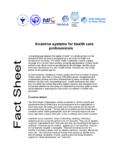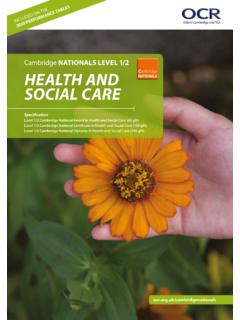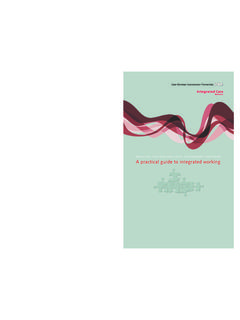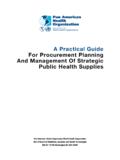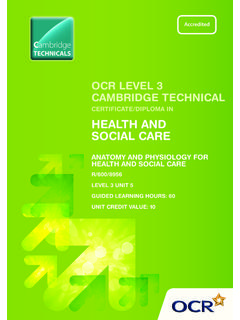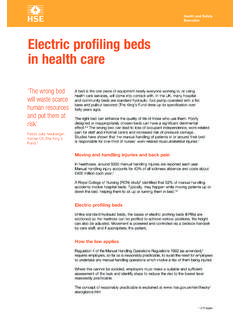Transcription of PROMOTING HEALTH ADVOCACY GUIDE FOR HEALTH …
1 1 PROMOTING HEALTH ADVOCACY GUIDE FOR HEALTH PROFESSIONALS INTERNATIONAL COUNCIL OF NURSES 2 All rights, including translation into other languages, reserved. No part of this publication may be reproduced in print, by photostatic means or in any other manner, or stored in a retrieval system , or transmitted in any form, or sold without the express written permission of the International Council of Nurses. Short excerpts (under 300 words) may be reproduced without authorisation, on condition that the source is indicated. Copyright 2008 by ICN - International Council of Nurses, 3, place Jean-Marteau, 1201 Geneva, Switzerland ISBN 978-92-95065-30-7 3 TABLE OF CONTENTS Policy change the system -level A note of SECTION 1: ETHICS, ADVOCACY AND GLOBAL Global SECTION 2: A FRAMEWORK FOR system -LEVEL HEALTH A 10-Step ADVOCACY 11 Step 1 : ADVOCACY is about taking 11 Step 2 : Selecting your 12 Step 3 : Understanding your political 13 Step 4 : Building your evidence 14 Step 5 : Engaging key 15 Step 6 : Developing strategic 17 Step 7 : Communicating messages and implementing 19 Step 8 : Seizing 21 Step 9 : Being 22 Step 10.
2 Taking a developmental 23 SECTION 3 : ADVOCACY TOOLS AND 25 Formative 27 Working with 29 Media 32 35 Social 36 Media 38 41 Internet-based 44 SECTION 4 : SECTION 5 : ANNEX 1:GLOSSARY OF HEALTH ADVOCACY Glossary 60 4 ACKNOWLEDGEMENTS ICN would like to acknowledge Franklin Apfel, the publication's main contributor for his hard work, and the Global HEALTH Workforce Alliance for its support in funding this document. 5 INTRODUCTION Teaching ourselves and patients to use anti-retrovirals is doable as long as we have a reliable supply of quality affordable drugs Zambian Nurse Teaching our children to cross the street safely is fine but slowing traffic by their school would really reduce the risk of accidents Hungarian physiotherapist Moving patients out of the hospital to the community is great as long as there are facilities and services available there Australian doctor All of us have ideas and concerns about how we might do things differently, and better, on our wards, and in our hospitals and communities.
3 All of us have our wish lists of policies, programmes and levels of funding that could lead to better HEALTH for our patients1 and communities. HEALTH ADVOCACY is an individual and collective approach that HEALTH professionals can use to turn these ideas into generalised realities and to create positive HEALTH and social change. A Definition of ADVOCACY Blending science, ethics and politics, ADVOCACY is self-initiated, evidence-based, strategic action that HEALTH professionals can take to help transform systems and improve the environments and policies which shape their patients behaviours and choices, and ultimately their HEALTH . The HEALTH professions see ADVOCACY as a core competence of professional practice, alongside scientific knowledge, clinical and inter-personal skills.
4 Although many good examples of effective HEALTH professional ADVOCACY exist, we see HEALTH ADVOCACY , particularly as it relates to influencing institutional, community, national and international policies, as an under-developed skill area in need of urgent strengthening. Whether you are a nurse, pharmacist, physician, dentist, physiotherapist, manager, or any other HEALTH professional, this GUIDE aims to provide you with a practical ADVOCACY action framework that you can use in your daily work. Section 1 provides an ethical rationale for action and identifies key global HEALTH trends driving the need and opportunities for strengthened HEALTH professional ADVOCACY . Section 2 identifies ten action steps which you can adapt to your own issues and contexts.
5 In Section 3, specific ADVOCACY skills and processes are described in more detail. These approaches can and have been used by HEALTH professionals in a wide variety of settings to enhance their own personal development, stand up for and with their patients, strengthen their professions, and facilitate policy change on institutional, community, regional, national and international levels. 1 The term patient is used throughout as a shorthand for service users, clients and other people receiving services from HEALTH professionals. 6 Policy change the system -level focus HEALTH professional advocacy2 can be applied at personal/professional,3 patient4 and policy change/ system levels.
6 While action in all these areas is needed, this GUIDE specifically focuses on how to argue for/promote policy change at a systems level. Such systems include any institution, community, citizen group, association or agency, governmental or non-governmental, public or private, national or international, with which HEALTH professionals work, that can, through their policies and power, influence public HEALTH and HEALTH care systems. Strong HEALTH professional ADVOCACY is critical in these policy arenas, not only to make the systems work better, particularly for vulnerable populations, but also to counteract the efforts of interest groups that stand to lose from the implementation of good public HEALTH practice.
7 A note of caution The recommendations in this GUIDE focus on ADVOCACY approaches in democratic countries. ADVOCACY assumes that people have rights and that these rights are enforceable; for example, the right to voice opinions openly and to organise, as well as the right to adequate HEALTH care, pollution-free environments, employment and housing. ADVOCACY often focuses on ensuring that these rights are exercised, respected and addressed. The approaches detailed in Section 3 are potentially effective only in political environments where: policy-makers can be influenced by public opinion; and/or governments can and do take action to protect the rights of their citizens; and/or there is an open and free media through which people can express themselves/find a voice (Sen 1990).
8 Where these public freedoms do not exist, the most effective way of changing policy may not be through direct ADVOCACY . It may require action from outside the country, from international agencies, and from actual and potential economic partners, as during apartheid in South Africa (Sida 2005). HEALTH professionals advocating for change in undemocratic environments may be putting themselves at risk and are advised to take a strategic, long-term perspective and, where possible, strengthen links with appropriate international ADVOCACY groups. 2 The term ADVOCACY , particularly in the sense in which it is used throughout this document, may not translate directly into some languages and several words may be needed to capture the sense of the English word.
9 The ADVOCACY focused on in this GUIDE is not legal ADVOCACY , pleading for another person in court or upholding the legal or human rights of one or a group of clients at their request (Wheeler 2000; Mallik 1998). 3 On a personal and professional level, HEALTH professionals can advocate for their rights as workers and for appropriate recognition of their contributions within their institutional community and environments. This could include trade union considerations, opportunities for training, participation in the decision-making processes, and a host of other issues. 4 Working for and with their more vulnerable patients/clients/service users and their carers, particularly when people in care are incapacitated or have a mental illness that affects their judgement, HEALTH professionals can advocate for fair and appropriate care and services.
10 This type of direct patient ADVOCACY necessitates that the HEALTH professional be respectful and knowledgeable of relevant ethical and legal implications of such third party representation; in particular, HEALTH professionals must weigh their duty of care against the autonomy of the person in care. Moreover, concerns have been raised about the lack of training and system support offered to HEALTH professionals in relation to their roles as patient advocates. (Teasdale, in Wheeler (2000) 7 SECTION 1 ETHICS, ADVOCACY AND GLOBAL TRENDS: The ethical basis for HEALTH professional ADVOCACY is articulated and enshrined in many international and national professional association codes.)
